The NVIDIA GeForce GTX 780 Ti Review
by Ryan Smith on November 7, 2013 9:01 AM ESTOverclocking
Finally, let’s spend a bit of time looking at the overclocking prospects for the GTX 780 Ti. Although GTX 780 Ti is now the fastest GK110 part, based on what we've seen with GTX 780 and GTX Titan there should still be some headroom to play with. Meanwhile there will also be the matter of memory overclocking, as 7GHz GDDR5 on a 384-bit bus presents us with a new baseline that we haven't seen before.
| GeForce GTX 780 Ti Overclocking | ||||
| Stock | Overclocked | |||
| Core Clock | 876MHz | 1026MHz | ||
| Boost Clock | 928MHz | 1078MHz | ||
| Max Boost Clock | 1020MHz | 1169MHz | ||
| Memory Clock | 7GHz | 7.6GHz | ||
| Max Voltage | 1.187v | 1.187v | ||
Overall our overclock for the GTX 780 Ti is a bit on the low side compared to the other GTX 780 cards we’ve seen in the past, but not immensely so. With a GPU overclock of 150MHz, we’re able to push the base clock and maximum boost clocks ahead by 17% and 14% respectively, which should further extend NVIDIA’s performance lead by a similar amount.
Meanwhile the inability to unlock a higher boost bin through overvolting is somewhat disappointing, as this is the first time we’ve seen this happen. To be clear here GTX 780 Ti does support overvolting – our card offers up to another 75mV of voltage – however on closer examination our card doesn’t have a higher bin within reach; 75mV isn’t enough to reach the next validated bin. Apparently this is something that can happen with the way NVIDIA bins their chips and implements overvolting, though this the first time we’ve seen a card actually suffer from this. The end result is that it limits our ability to boost at the highest bins, as we’d normally have a bin or two unlocked to further increase the maximum boost clock.
As for memory overclocking, we were able to squeeze out a bit more out of our 7GHz GDDR5, pushing our memory clock 600MHz (9%) higher to 7.6GHz. Memory overclocking is always something of a roll of the dice, so it’s not clear here whether this is average or not for a GK110 setup with 7GHz GDDR5. Given the general drawbacks of a wider memory bus we wouldn’t be surprised if this was average, but at the same time in practice GK110 cards haven’t shown themselves to be as memory bandwidth limited as GK104 cards. So 9%, though a smaller gain than what we’ve seen on other cards, should still provide GTX 780 Ti with enough to keep the overclocked GPU well fed.
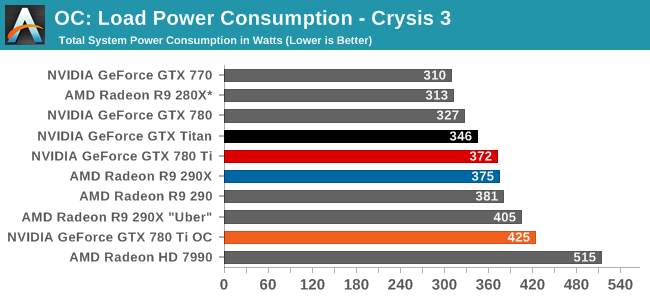
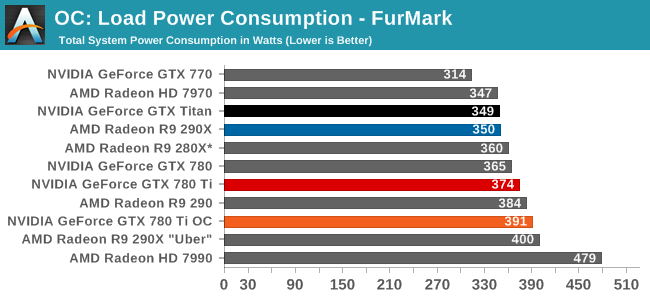
Starting as always with power, temperatures, and noise, we can see that overclocking GTX 780 Ti further increases its power consumption, and to roughly the same degree as what we’ve seen with GTX 780 and GTX Titan in the past. With a maximum TDP of just 106% (265W) the change isn’t so much that the card’s power limit has been significantly lifted – as indicated by FurMark – but rather raising the temperature limit virtually eliminates temperature throttling and as such allows the card to more frequently stay at its highest, most power hungry boost bins.
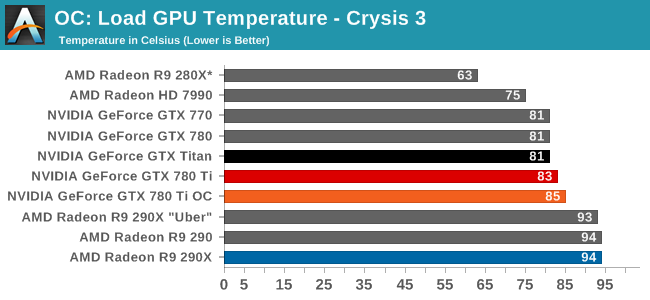

Despite the 95C temperature target we use for overclocking, the GTX 780 Ti finds its new equilibrium point at 85C. The fan will ramp up long before it allows us to get into the 90s.
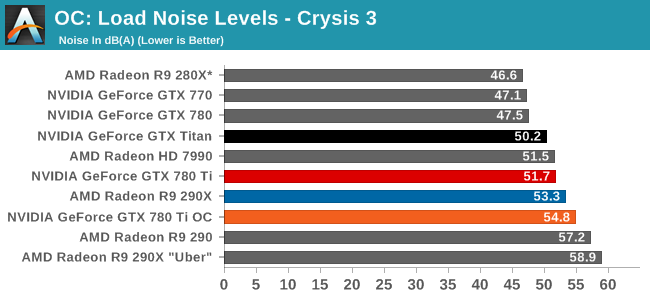
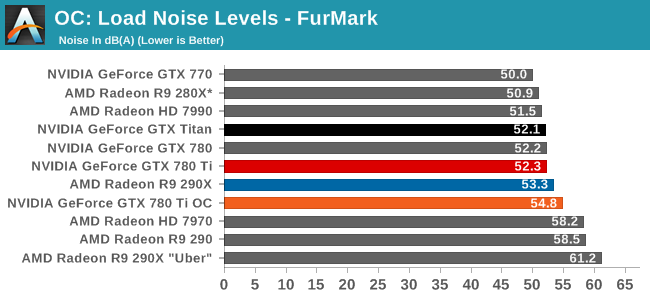
Given the power jump we saw with Crysis 3 the noise ramp up is surprisingly decent. A 3dB rise in noise is going to be noticeable, but even in these overclocked conditions it will avoid being an ear splitting change. To that end overclocking means we’re getting off of GK110’s standard noise efficiency curve just as it does for power, so the cost will almost always outpace the payoff on a relative basis.
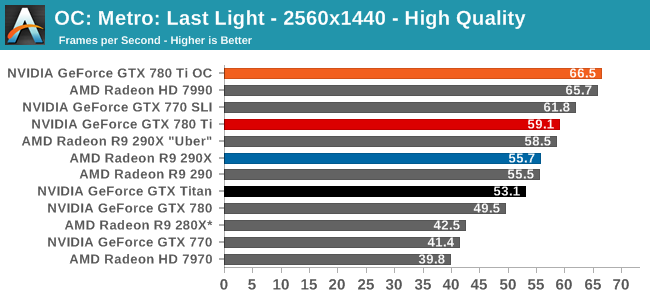
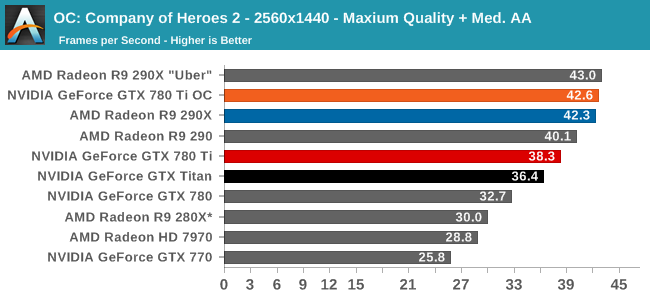
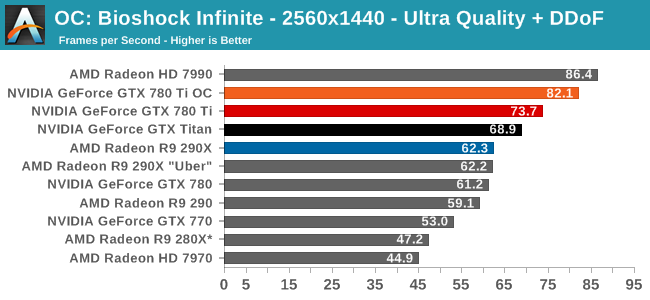
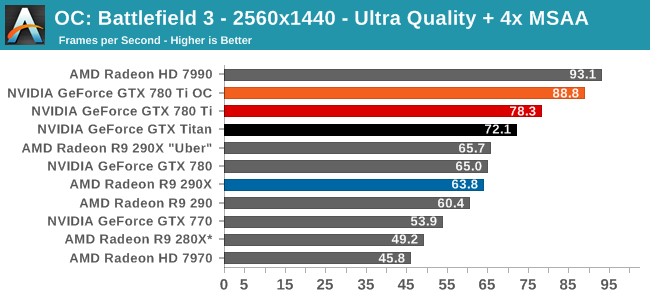
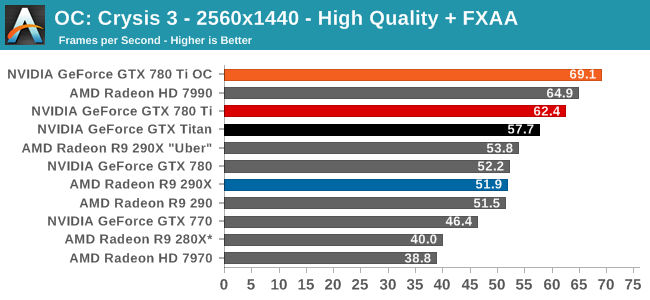
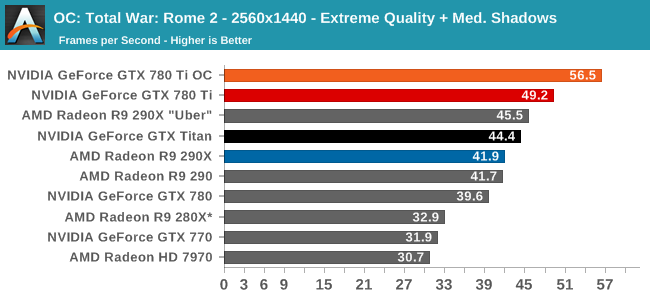
Finally, looking at gaming performance the the overall performance gains for overclocking are generally consistent. Between our 6 games we see a 10-14% performance increase, all in excess of the memory overclock and closely tracking the GPU overclock. GTX 780 Ti is already the fastest single-GPU card, so this only further improves its performance lead. But it does so while cutting into whatever is above it, be it the games where the stock 290X has a lead, or multi-GPU setups such as the 7990.










302 Comments
View All Comments
IUU - Saturday, November 9, 2013 - link
So, the high end of video cards can run shamelessly all the "high" end titles at 2560x1440. What are the game developers doing? So much computing power being wasted for viewing our games at nonsensical resolutions? There's still room for improvement of the game visuals, why don't they take advantage of the cards' muscle?I may be eccentric, but for some peculiar reason, I don't get excited by playing pacman and supermario at ultra hd.
Vortac - Saturday, November 9, 2013 - link
Folding@home double precision benchmark results are somewhat strange to me. How can a 780 Ti card (with FP64=1/24 FP32) beat a 7970 aka 280X (with FP64=1/4 FP32)?abhishek_takin - Sunday, November 10, 2013 - link
780ti is great card in terms of performance. But 700$ is too much to ask. As a gamer Max FPS is not everything. It should smooth and fast with Ultra / High details. I have 7970GHZ crossfire with 27 inch Dell dual monitor setup. My pc smokes all the latest game in the market. And ask me how much i paid 640$ and bunch of free games. I know the problem of crossfire but its not that huge for which one should opt for a single card for 700$.I am not a fanboy of Nvidia or AMD. If the card's price would be under 550$ then everyone would be saying that.... its the best card ever made. Only because of its big price tag lots of people are voting for 290X, 290 and 780(normal) which is very much fair.
nsiboro - Sunday, November 10, 2013 - link
780ti burnthttp://www.chiphell.com/thread-897838-2-2.html
NV issue stop sale
http://www.chiphell.com/thread-897383-11-1.html
What's happening?
Can someone confirm this?
polaco - Sunday, November 10, 2013 - link
who on earth will be able to confirm a post on a page written in chineese?nsiboro - Sunday, November 10, 2013 - link
Yer right.How about in English.
http://linustechtips.com/main/topic/74131-chiphell...
nsiboro - Monday, November 11, 2013 - link
Could be a hoax. The posted image of the burnt PCI-E connector doesn't look like a 780ti.nsiboro - Monday, November 11, 2013 - link
It's confirmed to affect Galaxy branded GTX-780ti.http://translate.google.com/translate?sl=auto&...
UPDATE: It is reported GALAXY official has released a formal announcement, said 2013 sales between 11.7-11.10 GTX 780 Ti existence of quality defects, serial number 13B0020705-13B0020759 a total of 55 cards between the user can call the official customer service phone 400-700 -3933 for a free replacement.
Skr13 - Sunday, November 10, 2013 - link
Please fix typo at the Company of Heroes 2 page: http://postimg.org/image/u96hy7skf/62e3b91a/DPOverLord - Monday, November 11, 2013 - link
What about on Surround monitors, the main draw for the Titan was that it has 6GB of Ram.